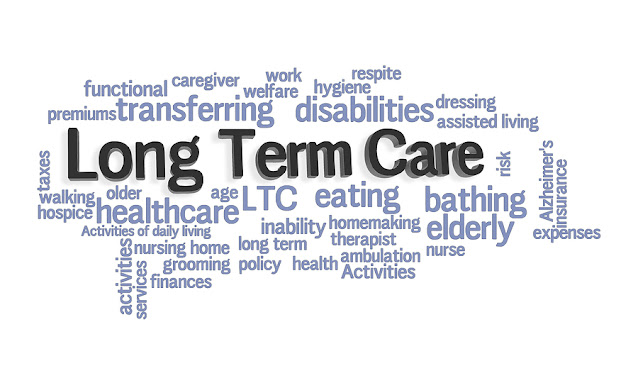Long-Term Care Insurance Basics
Long-term care insurance pays for services to help individuals who are unable to
perform certain activities of daily living without assistance, or require supervision due to a cognitive impairment such as Alzheimer’s disease.
Features of Long-Term Care Policies
The best policies pay for care in a nursing home, assisted living facility, or at
home. Benefits are typically expressed in daily amounts, with a lifetime maximum. Some policies pay half as much per day for at-home care as for nursing
home care. Others pay the same amount, or have a “pool of benefits” that can
be used as needed.
Criteria for the Beginning of Payments
The policy should state the various conditions that must be met. They can
include:
1. The Inability to Perform Two or Three Specific “Activities of Daily Living” Without Help
These include bathing, dressing, eating, toileting and “transferring” or being
able to move from place to place or between a bed and a chair.
2. Cognitive Impairment
Most policies cover stroke and Alzheimer’s and Parkinson’s disease, but other
forms of mental incapacity may be excluded.
3. Medical Necessity or Certification by a Doctor that Long-Term Care is Necessary
Most policies have a “waiting period” or “elimination” period. This is a period
that begins when an individual first needs long-term care and lasts as long as
the policy provides. During the waiting period, the policy will not pay benefits.
The policy pays only for expenses that occur after the waiting period is over,
if the policyholder continues to need care. In general, the longer the waiting
period, the lower the premium for the long-term care policy. Benefit periods for long-term care may range from two years to a lifetime.
Premiums can be kept down by electing coverage for three to four years longer
than the average nursing home stay instead of a lifetime.
Most long-term care policies pay on a reimbursement (or expense-incurred)
basis, up to the policy limits.
In other words, if the policy has a $150 per day
benefit, but the policyholder spends only $130 per day for a home long-term
care provider, the policy will pay only $130. The “extra” $20 each day will, in some policies, go into a “pool” of unused funds that can be used to extend the
length of time for which the policy will pay benefits.
Other policies pay on an
indemnity basis. Using the same example as above, an indemnity policy would
pay $150 per day as long as the insured needs and receives long-term care services, regardless of the actual outlay.
Inflation protection is an important feature, especially for people under the
age of 65, who are buying benefits that they may not use for 20 years or more.
A good inflation provision compounds benefits at 5 percent a year.
Without
inflation protection, even 3 percent annual inflation will, over 24 years, reduce
the purchasing power of a $150 daily benefit to the equivalent of $75.
Six Other Important Policy Provisions
1. Elimination Period
Under some policies, if the insured has qualifying long-term care expenses
on one day during a seven-day period, he or she will be credited with having
satisfied seven days toward the elimination period: i.e., the time between an
injury and the receipt of payments. This type of provision reflects the way
home care is often delivered some days by professionals and some days by
family members.
2. Guaranteed Renewable Policies
These must be renewed by the insurance company, although premiums can go
up if they are increased for an entire class of policyholders.
3. Waiver of Premium
This provision ensures that no further premiums are due once the policyholder
starts to receive benefits.
4. Third-Party Notification
This provision stipulates that a relative, friend or professional adviser will be
notified if the policyholder forgets to pay a premium.
5. Nonforfeiture Benefits
These benefits keep a lesser amount of insurance in force if the policyholder lets
the coverage lapse. This provision is required by some states.
6. Restoration of Benefits
This provision ensures that maximum benefits are put back in place if the
policyholder receives benefits for a time, then recovers and goes for a specified
period (typically six months) without receiving benefits.



Posting Komentar untuk "Long-Term Care Insurance Basics"